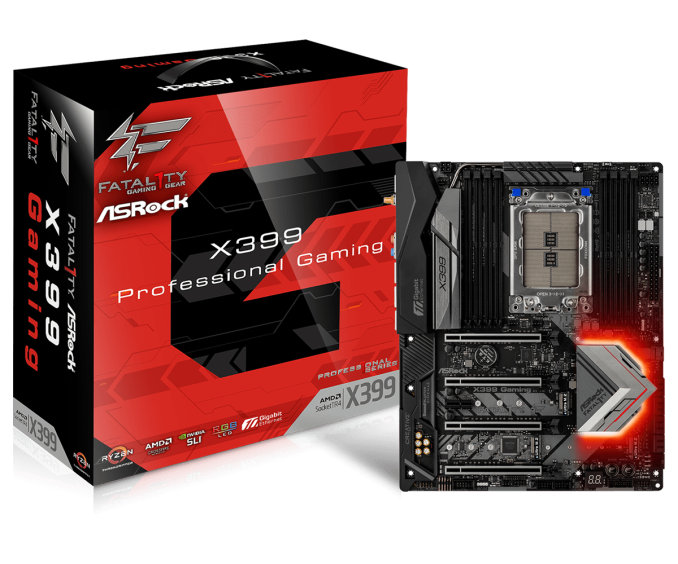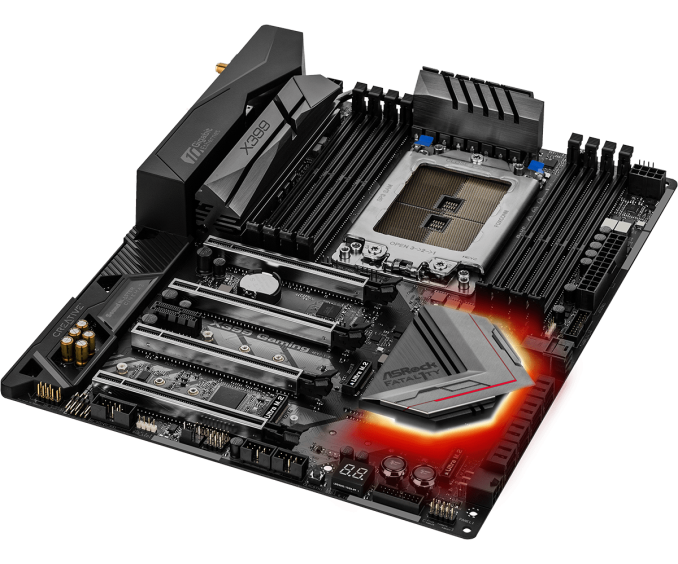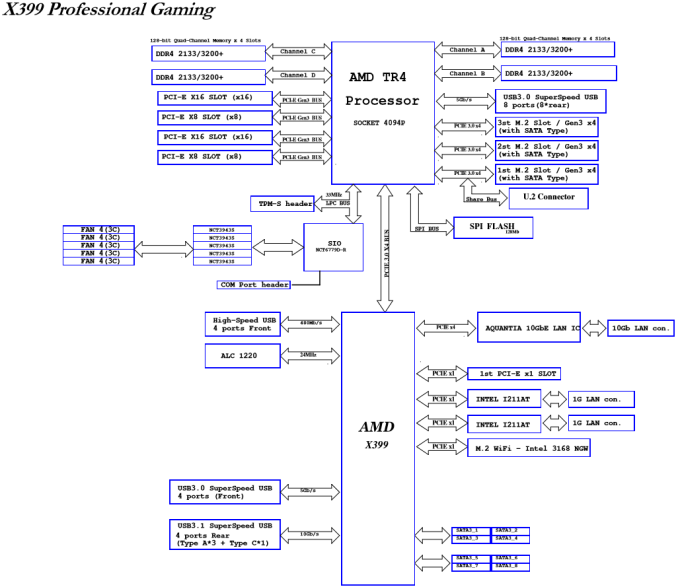An AMD Threadripper X399 Motherboard Overview: A Quick Look at Seven Products
by Ian Cutress & Joe Shields on September 15, 2017 9:00 AM ESTASRock
No stranger to the fray, ASRock is ready with the launch of two boards, the X399 Professional Gaming and X399 Taichi. Both boards share features but have enough differences to separate them in the product stack. The Pro Gaming adds 10 Gigabit Ethernet to its two Gigabit NICs and supports Creative Sound Blaster Cinema 3, while the Taichi aims to be a more mid-range board, by sticking with dual Gigabit NICs and uses Purity Sound 4. The styling is a little different too.
ASRock X399 Professional Gaming
The high-end board from ASRock will be the Professional Gaming. It also carries the Fatal1ty name, due to ASRock’s never-ending association with a pro-gamer from the turn of the century.
On the aesthetic side, the X399 Professional Gaming has a black PCB accented with gray heatsinks and grey stenciling where the M.2 slots are located. The memory slots are black, along with the rear IO cover that extends down the board. There are two heatsinks to cool the VRMs, connected by a heatpipe, and one reaches near to the rear IO. The chipset heatsink is not connected as part of the VRM cooling, but consumes a fairly large portion of the board and looks a bit like a play button. As with the fascination with RGB, the Professional Gaming has a few under the chipset heatsink. Users can add more RGB LEDs via two headers, and control them all through ASRock's RGB LED application.
The Professional Gaming has support for both NVIDIA 4-Way SLI and AMD 4-Way Crossfire with full-length PCIe slots. These have additional reinforcement to prevent sag or bending due to heavy PCIe cards during transit – the reinforcement is what ASRock calls its ‘Steel Armor’. The PCIe slots give an x16/x8/x16/x8 configuration from top to bottom, using 48 of the 60 PCIe lanes from the processor. The rest of the lanes are allocated to storage: there are a total of three M.2 PCIe 3.0 x4 slots, one of which is shared/switched with a U.2 connector. For other storage, there are eight SATA ports from the chipset that natively support RAID 0/1/10.
For added features, the X399 Professional Gaming jumps past the ever-present Gigabit Ethernet and uses an Aquantia AQC107 10 Gigabit LAN controller to appeal to users that want to invest in 10GbE. This is paired with two Intel I211AT network controllers, and all three can do regular gigabit Ethernet duties. If three Ethernet ports were not enough, also included is an integrated Intel AC8265 2x2 802.11a/b/g/n/ac WiFi module, to handle wireless duties.
ASRock provided chipset diagram for the Pro Gaming to show how it breaks down all the bandwidth:
For power delivery, ASRock uses a digital 11 phase International Rectifier solution, along with IR DrMOS for monitoring VRM current and temperature. Distributing power to the VRMs are two EPS 12V connectors, an 8-pin and a 4-pin, although the system will work with only the 8-pin installed. Typically we see EPS connectors oriented close to each other at the top of the motherboard, but here the connectors are located on opposite sides of the socket. As shown above, the 8-pin is in the upper right-hand corner above the DIMM slots, while the supplemental 4-pin is in the more familiar location at the top left-hand corner. ASRock asserts this creates a wider trace for the CPU VRM, bringing better power delivery efficiency and lowering temperatures.
For USB connectivity, the Professional Gaming has three USB 3.1 (10 Gbps) Type-A ports on the rear, one USB 3.1 (10 Gbps) Type-C port on the rear, two USB 3.1 (5 Gbps) headers for front panel ports, and two USB 2.0 headers for front panel ports.
| Fatal1ty X399 Professional Gaming | |
| Warranty Period | 3 Years |
| Product Page | Link |
| Price | $439.99 |
| Size | ATX |
| CPU Interface | TR4 |
| Chipset | AMD X399 |
| Memory Slots (DDR4) | Eight DDR4 Slots, up to 3600 MT/s Supporting 128GB Quad Channel |
| Network Connectivity | 1 x Aquantia AQC107 10 Gigabit LAN 2 x Intel I211AT GbE |
| Wireless Network | 802.11 ab/g/n/ac Dual-Band (2.4/5 GHz) Bluetooth 4.2 |
| Onboard Audio | Realtek ALC1220 |
| PCIe Slots | 4 x PCIe 3.0 (x16/x8/x16/x8) from CPU 2 x PCIe 2.0 x1 from Chipset |
| Onboard SATA | 8 x SATA 6 Gbps Supporting RAID 0/1/5/10 |
| Onboard SATA Express | None |
| Onboard M.2 | 3 x PCIe 3.0 x4 - NVMe or SATA |
| Onboard U.2 | 1 x PCIe 3.0 x4 (disables M2_1 when in use) |
| USB 3.1 | 1 x Type-A , 1 x Type-C (Rear Panel) |
| USB 3.0 | 8 x Rear Panel, 4 x via internal headers |
| USB 2.0 | 4 x via internal headers |
| Power Connectors | 1 x 24-pin ATX 1 x 8-pin CPU 1 x 4-pin CPU |
| Fan Headers | 1 x CPU 1A/12W Max. (4-pin) 1 x CPU Opt/Water Pump 1.5A/18W Max. (4-pin) 2 x Chassis (4-pin) 1 x Chassis Opt/Water Pump 1.(4-pin) |
| IO Panel | 2 x Antenna Ports 1 x PS/2 Mouse/Keyboard Port 1 x Optical SPDIF Out Port 1 x USB 3.1 Type-A Port (10 Gb/s) 1 x USB 3.1 Type-C Port (10 Gb/s) 8 x USB 3.0 Ports 4 x USB 3.0 Ports 3 x RJ-45 LAN Ports w/ LED 1 x BIOS Flashback Switch HD Audio Jacks |
















99 Comments
View All Comments
HStewart - Friday, September 15, 2017 - link
You got to give some credit to AMD clever marketing teams by naming this x399 when Intel has x299 and then calling this the "The Most Advanced Desktop Motherboard in the World"But in reality there is no Thunderbolt 3.0 support and most likely be updated next year or later with PCIe 4.0 support.
Does it support DDR4-4600?
AMD sure likes to play numbers game and not just chipset name - but with number cores - just remember it mostly marketing - yes it still 16 cores - but 16 cores by one manufacturer does not mean 16 cores from completion.
sartwell - Friday, September 15, 2017 - link
Where is the high speed RAM? You cannot get it anywhere.HowardJones - Friday, September 15, 2017 - link
If you're considering the ROG Zenith be aware that it's having tons of problems overclocking CPU and memory. Theres a huge thread on overclock dot net that is filled with people having problems with the bios. There WAS an Asus rep who was trying to help, but he's pretty much disappeared in the last few weeks.tamalero - Sunday, September 17, 2017 - link
Seems like your average typical Asus mainboard.Asus has really huge troubles in their software segment. I still remember they needed like 50 patches to get their high end routers stable. And yet they couldnt get all what they promised in a working condition and even disabled some stuff in later firmwares.
Same with bioses.
I still remember a time where you had to enable the "floppy" connector in a motherboard (even if you had no drive) if you wanted the bios to actually apply the overclocking settings.
mapesdhs - Tuesday, September 19, 2017 - link
A note for those with older ASUS ROG and other ASUS X79 boards, etc.: there's a thread on the ASUS ROG forum site where a guy has provided modded BIOS files to support booting from NVMe devices, aswell as rolling in all the updates to the latest microcode, Intel RAID, etc. Very handy indeed, and he takes requests for other ASUS boards. SSDs like the 950 Pro have their own boot ROM, but a BIOS with boot support is perfect for the 960 EVO/Pro and other models which don't have their own boot ROM.I just bought two R4Es (one basically new), a 4930K, a 16GB/2400 DDR3 kit and a 120mm AIO for a total of 320 UKP. Who needs new stuff? :D My next new build will be TR or EPYC though I'm sure.
satai - Saturday, September 16, 2017 - link
Are any details on X399 AORUS Gaming 7 power delivery solution?The rumor was, that the used only 8 phase, but 8s this true for the final design?
danjw - Saturday, September 16, 2017 - link
The Asus Zenith Extreme claims to support 4-way SLI, but I thought Nvidia didn't support 4x slots for SLI? Am I wrong? Or is this a false claim?DanNeely - Saturday, September 16, 2017 - link
Cynically I'm going to guess that if you use several generation old cards that did support 4 way SLI you could combine all 4 together for an act of supreme WTFery.danjw - Saturday, September 16, 2017 - link
I looked at the manual for the Zenith Extreme. It claims the two that the block diagram of the board in this review indicates are 4x are 8x, with the lowest one on the board being 8x as long as you don't have a U.2 drive connected to the U.2 port. So, it is unclear which is correct the block diagram or the manual.danjw - Sunday, September 17, 2017 - link
Apparently, the block diagram wasn't clear. That last slot is 8x/4x depending on if you have a U.2 drive connected.